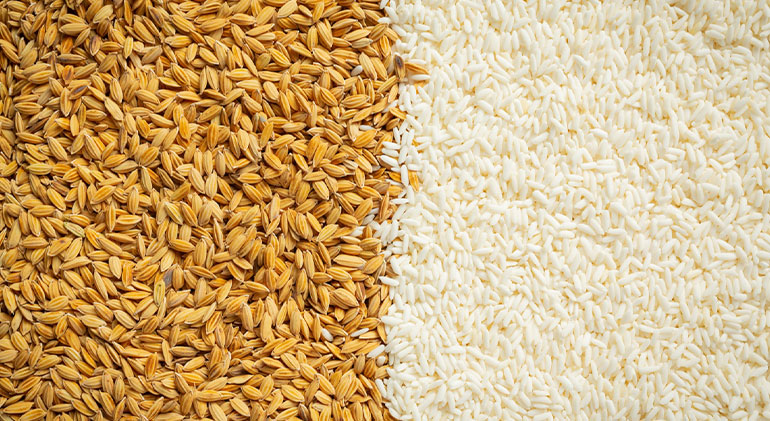Rice, a cherished staple for over half of the world’s population, holds a special place in our kitchens, cultures, and economies. It’s not just a grain; it’s a way of life. As the world becomes more interconnected, rice exporters play a pivotal role in ensuring that this essential food reaches consumers worldwide in its best form. In this blog, we will embark on a journey with Basmati rice, one of the most beloved varieties, and explore how it travels from the lush fields to our dining tables while maintaining its quality and essence.
In the story of India’s rice business, a big change happened during the Green Revolution. Before this farming revolution, other countries like Thailand and Vietnam were ahead because they had better farming methods.
The Green Revolution started in the 1960s and brought big changes to Indian farming. It showed farmers new ways to grow crops, provided seeds which produced more yield and taught them better irrigation methods. As a result of the Green Revolution, Indian farmers were able to grow a greater amount of rice. They used new varieties of rice that were tougher against pests and diseases. India not only had enough rice for its own people, but also had a surplus that could be exported. This is also when the special Basmati rice from India became very popular worldwide.
India’s success in rice exports was impressive. It quickly beat Thailand and Vietnam, who were dominating the market before. Combined with better farming, good weather and the delicious Basmati rice, India became a top rice exporter. This shows how the Green Revolution changed farming in India and helped it become a world leader in rice trade and export. Today, India is a proud rice exporter. A country that used to depend on rice imports has now become a major rice exporter. The aromatic Basmati rice, with its long, slender grains and distinctive fragrance, has played a significant role in this transformation.
One of the key differentiators for these emerging rice exporters is their willingness to embrace technology. From precision agriculture techniques to efficient supply chain management, technology is at the heart of improving productivity and reducing wastage. In the case of Basmati rice, precision cultivation methods help maintain the grain’s unique characteristics, ensuring its premium quality. Sustainability is no longer just a buzzword. It’s a way of life for modern rice exporters. Conscious of the environmental impact of rice cultivation, exporters are adopting eco-friendly practices.
Basmati rice has transcended its traditional role as a simple staple and entered the realm of gourmet cuisine. To cater to diverse global tastes, exporters invest in processing facilities to produce value-added Basmati products. These include ready-to-cook Basmati rice, Basmati rice flour, and more. Diversification not only broadens export potential but also satisfies the evolving preferences of global consumers. The journey of Basmati rice quality begins at the source – the farms. Reliable Basmati rice exporters build strong relationships with trusted farmers and cooperatives who have a history of quality cultivation practices. They carefully select Basmati rice varieties known for their exceptional taste, texture, and nutritional value.
Timing is critical in maintaining the excellence of Basmati rice. Distributors work closely with farmers to determine the perfect time for harvesting. This ensures that Basmati rice grains are at their peak in terms of flavor, aroma, and texture, preventing over-mature or under-mature grains from entering the supply chain. Once harvested, Basmati rice undergoes a series of cleaning processes to remove impurities such as dirt, debris, and husk. Modern milling techniques are employed to separate the outer husk from the inner grain, resulting in “Brown Basmati rice.” Further milling can yield white Basmati rice, where the bran and germ layers are removed. Exporters carefully choose the level of milling to maintain the desired nutritional value and texture of Basmati rice.
Rigorous quality control checks are conducted at this stage. Trained experts meticulously examine the Basmati rice for factors such as size, shape, color, and overall appearance. Any grains that don’t meet the defined quality standards are removed to ensure only the best make it to the export stage. Proper packaging is essential for preserving Basmati rice quality during transportation. Exporters use materials that protect against moisture, pests, and physical damage. Appropriate containers prevent the growth of mold or the invasion of insects that could compromise the quality of Basmati rice.
During transportation, exporters ensure that Basmati rice is stored and transported in controlled environments to prevent moisture absorption or loss, which could affect the texture and taste of the rice.
Transparency throughout the supply chain is crucial. Exporters maintain detailed records of the Basmati rice’s journey, from the farm to the consumer. This traceability helps identify the source of any potential quality issues and allows for prompt corrective actions. To cater to the global market, Basmati rice exporters adhere to international quality standards set by organisations such as the International Organisation for Standardisation (ISO) and the Food and Agriculture Organisation (FAO). This ensures that Basmati rice meets the requirements of different countries and maintains a consistent quality profile.
Conclusion
The journey of Basmati rice from farm to table is a testament to the dedication and precision of rice exporters. Their commitment to excellence ensures that consumers worldwide can savor the unique flavor, aroma, and nutrition that Basmati rice has to offer. As the world evolves and global markets expand, these exporters play a vital role in preserving the authenticity and quality of this beloved grain, creating a path for Basmati rice to shine on dining tables around the world. These ‘golden grains’ are not just food; they are a symbol of culture and tradition.



